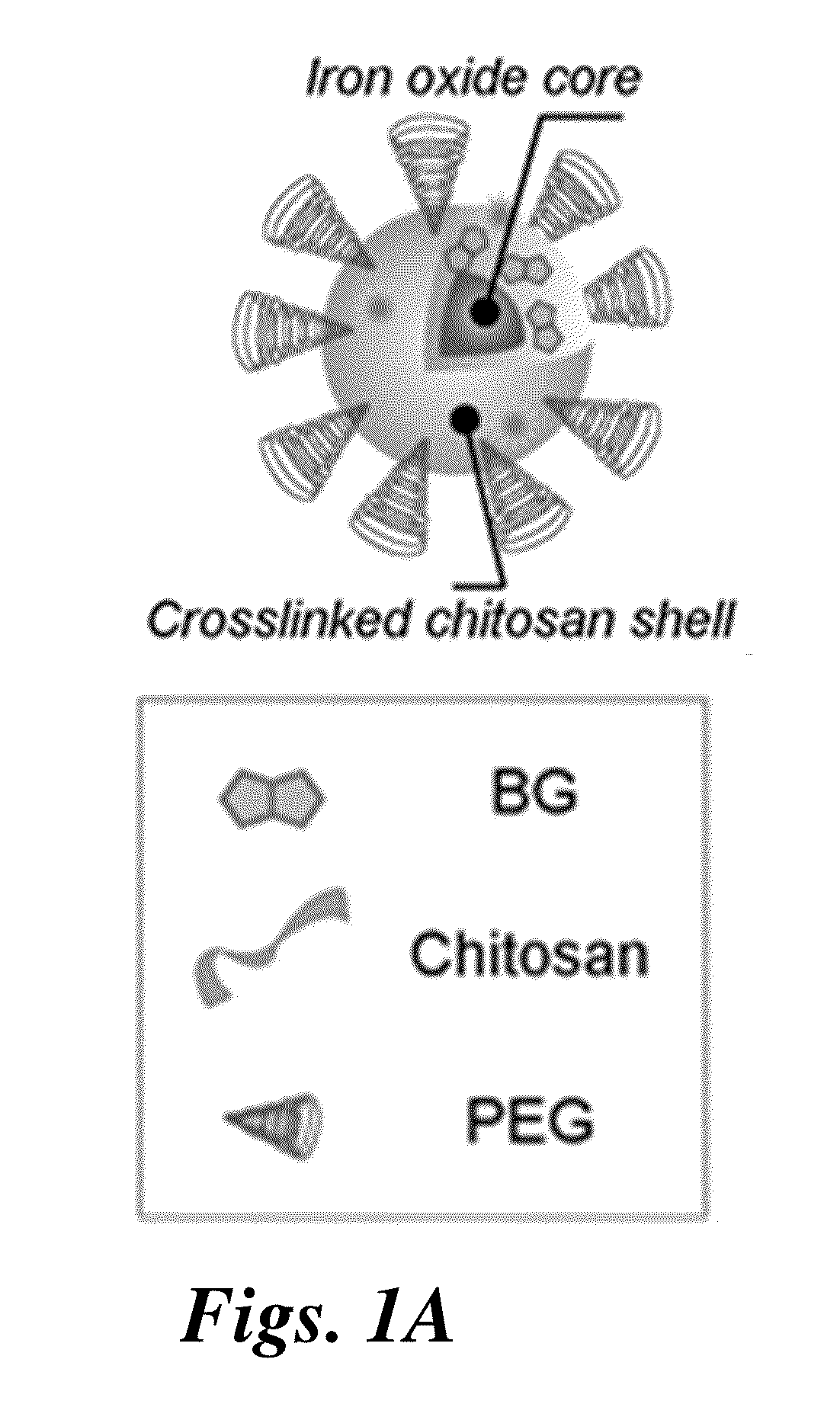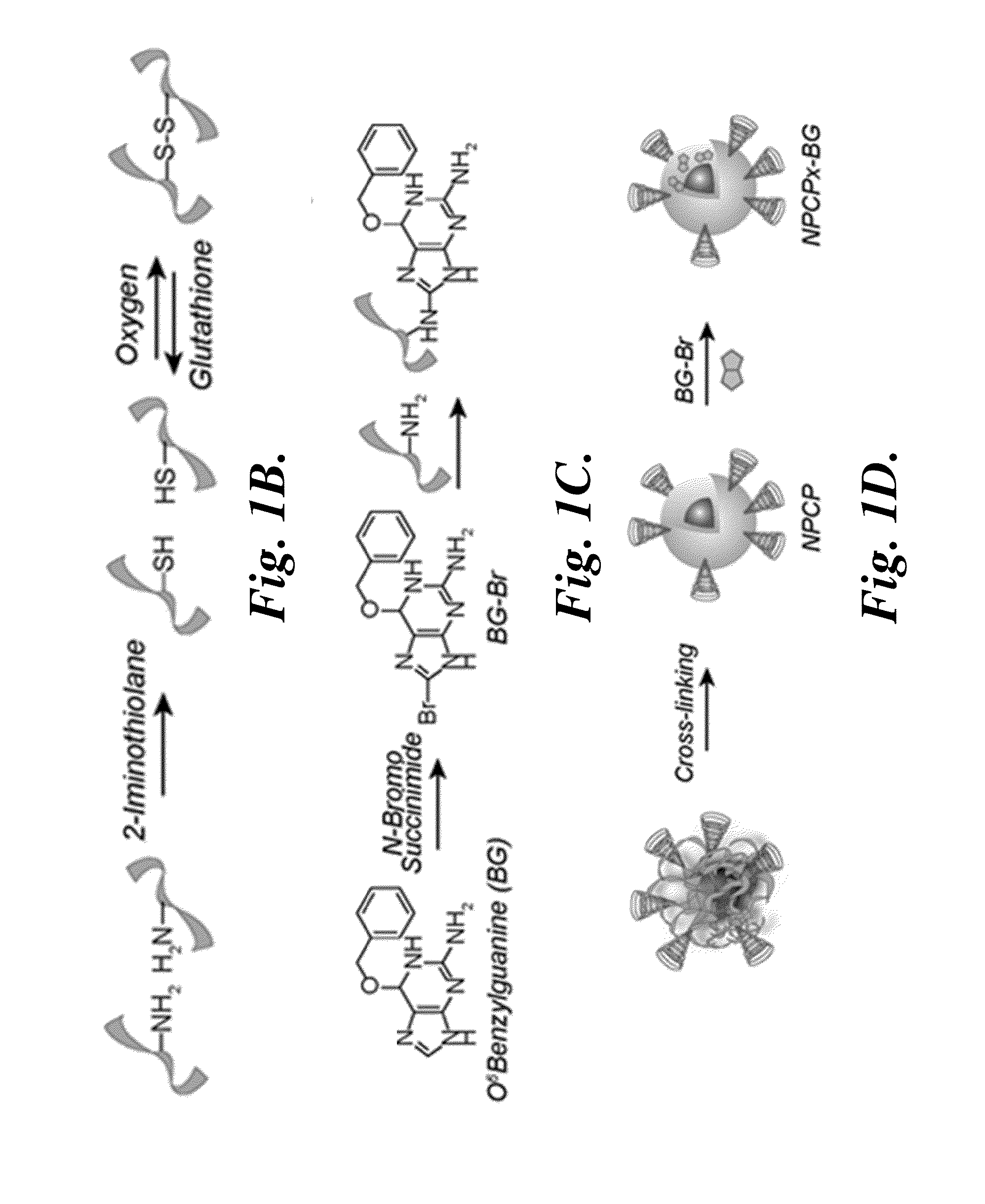Nanoparticle for targeting brain tumors and delivery of o6-benzylguanine
a technology of benzylguanine and nanoparticles, which is applied in the direction of powder delivery, microcapsules, tissue culture, etc., can solve the problems of reducing the maximum tolerated dose (mtd) of tmz by 50%, the clinical outcome is not improved by tmz in the majority of gbms, and the inclusion of bg in tmz treatment regimens reduces the maximum tolerated dose (mtd) of tmz
- Summary
- Abstract
- Description
- Claims
- Application Information
AI Technical Summary
Benefits of technology
Problems solved by technology
Method used
Image
Examples
example
Example 1
[0137]Materials.
[0138]All reagents were purchased from Sigma Aldrich (St. Louis, Mo.) unless otherwise specified. The heterobifunctional linker 2-iminothiolane (Traut's reagent) was purchased from Molecular Biosciences (Boulder, Colo.). NHS-PEG12-maleimide was purchased from Thermo Fisher Scientific (Rockford, Ill.). Tissue culture reagents including Dulbecco's modified Eagle medium (DMEM) and antibiotic-antimycotic were purchased from Invitrogen (Carlsbad, Calif.). Fetal bovine serum (FBS) was purchased from Atlanta Biologicals (Lawrenceville, Ga.).
[0139]NPCP Synthesis.
[0140]Iron oxide nanoparticles coated with a copolymer of chitosan-grafted-PEG were synthesized via a co-precipitation method as previously reported (Veiseh et al., Cancer Res. 2009, 69, 6200-7). Briefly, chitosan oligosaccharide (5,000 kDa) was PEGylated with aldehyde-activated methoxy PEG, and monolabeled chitosan-grafted-PEG (CP) was purified using ion exchange chromatography. Pure CP (150 mg) was mixed w...
example 2
Preparation of Brominated Benzylguanine
[0166]In this example, the preparation of brominated benzylguanine (BG-Br) is described. Bromination of benzylguanine (BG) at the C8 position was performed to covalently couple BG to NPCPx.
[0167]BG (2.4 mg) was dissolved in 500 μL methanol (MeOH) and mixed with N-bromosuccinimide (2 mg) dissolved in 500 μL MeOH. The reaction was maintained in the dark at room temperature for 24 hr to provide brominated BG (BG-Br). MeOH was removed under vacuum.
[0168]A Hewlett Packard 1100 Liquid Chromatography (LC) system (Palo Alto, Calif., USA), with autosampler, was coupled to a Bruker Esquire ion trap mass spectrometer (Billerica, Mass., USA) with electrospray ionization (ESI) source. The benzylguanine / N-bromosuccinimide reaction mixture was separated with an Agilent Zorbax narrow bore C18 column that was 100 mm×2.1 mm i.d. with 3.5 μm particle size (Agilent, Santa Clara, Calif., USA). A binary mobile phase system of solvent A (water with 5% acetonitrile an...
example 3
[0172]Optimization of Crosslinked Coating
[0173]In this example, optimization of crosslinking of the NPCP copolymer coating is described.
[0174]Optimization Procedure.
[0175]Disulfide bond formation was utilized to further stabilize the NPCP for subsequent conjugation of BG, fluorescent probes, and CTX, as well as provide a mechanism for release of drug within target cells. To optimize crosslinking, amine reactive Traut's reagent was reacted with NPCPs at 10:1, 5:1, and 2.5:1 weight ratio Traut's reagent:iron. The stability of the crosslinked NPCPs were compared to non-crosslinked NPCPs in PBS in terms of hydrodynamic size change over time. Crosslinking dramatically stabilized the nanoparticle at all three Traut's reagent ratios. Because the reaction with Traut's reagent consumes amines that are necessary for subsequent conjugations, the number of reactive amines of NPCP and NPCPx produced at the three crosslinking ratios was determined and the results summarized in Table 2.
TABLE 2Amin...
PUM
| Property | Measurement | Unit |
|---|---|---|
| mean core size | aaaaa | aaaaa |
| hydrodynamic size | aaaaa | aaaaa |
| pH | aaaaa | aaaaa |
Abstract
Description
Claims
Application Information
 Login to View More
Login to View More - R&D
- Intellectual Property
- Life Sciences
- Materials
- Tech Scout
- Unparalleled Data Quality
- Higher Quality Content
- 60% Fewer Hallucinations
Browse by: Latest US Patents, China's latest patents, Technical Efficacy Thesaurus, Application Domain, Technology Topic, Popular Technical Reports.
© 2025 PatSnap. All rights reserved.Legal|Privacy policy|Modern Slavery Act Transparency Statement|Sitemap|About US| Contact US: help@patsnap.com



